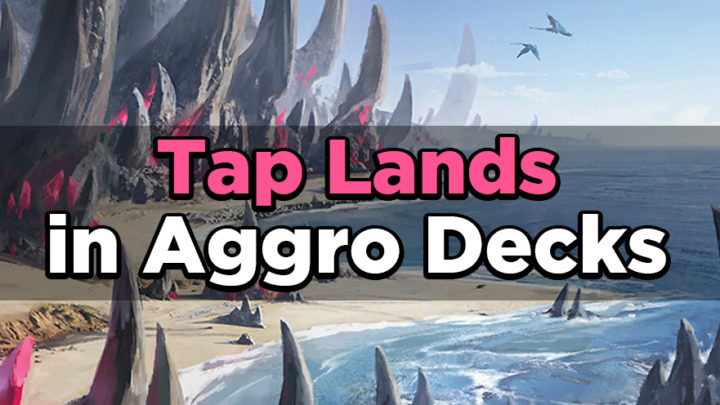Sometimes, in Standard, we have access to a lot of lands that come into play tapped. These are exciting for deck-building purposes because they give you access to more colors of mana, which, in turn, provides players with a ton of flexibility.
But lands that enter the battlefield tapped have major downsides. You don’t have immediate access to the mana those lands can produce, which can sometimes put you a full turn behind your opponent.
Of course, not all lands that enter play tapped are created equal. Some of these lands allow you to gain one life when they enter the battlefield. Some let you scry, so you can set up a more powerful turn in the future. Others let you cycle them for a new card.
In this article, I want to focus on the two most popular types of lands in this category in the current Standard format: Triomes and Temples. These lands can be tricky to evaluate, especially for aggressive decks that want to play efficient spells and deal damage quickly. Lands that enter play tapped could trip you up as you execute your game plan, but they may be your best option if you want a consistent mana base.
Let’s look at a few sample hands and see how these lands can affect mulligan decisions.
Example #1

In this hand, the Temple of Abandon doesn’t pose any problems. Generally, Temples can be problematic on turns one and three, but that’s not the case here. If you were to lead with the Temple, you’d be able to play any of your cards on turn two.
Example #2
Okay, that one was a bit of a no-brainer. Time for a tougher decision with the same Gruul Aggro deck.

This time, there are two Temples in your opening hand, so you won’t be able to curve out as easily. Assuming you don’t draw any lands that come into play untapped in the next few turns, you’ll have to choose between playing Scorching Dragonfire on turn two and playing Gruul Spellbreaker on turn three.
Also consider what you might do if you drew it on a mulligan to six. In that case, I would recommend putting Embercleave on the bottom of your library; you’re unlikely to play it before turn five, and your other cards will be more impactful leading up to that point.
However, this hand does showcase the power of the Temples’ scry effect. Knowing what’s on top of your library over the first four turns will give you much clearer direction on how to sequence your plays.
Additionally, having access to two colors of mana is critical when you have hands like this. The Temples could also allow you to safely play two cards a turn later in the game without worrying about color requirements.
Example #3

Now, let’s look at a Jeskai Cycling deck. If this hand had no Raugrin Triome, you would have no real expectation of casting the Red cards and you would have a much different mulligan decision.
The biggest decision to make here is whether if it’s worth playing the Triome on turn one or not. Is having access to red mana worth forgoing your best turn one play, Flourishing Fox? It may be better to use the Hallowed Fountains over the first two turns, then start cycling the Drannith Stingers. And, of course, the play you make here may also depend on whether you’re on the play or the draw.
The bottom line is, if you choose to play Temples and Triomes, you need to build your deck with them in mind. In a cycling deck like this, Triomes can serve different purposes.
Example #4

This time, we’re looking at a Mardu Humans deck. This is a prime example of why aggro decks want the Triomes. When most of our basic lands are Plains, Savai Triome can provide critical access to your other two colors of mana. This hand would’ve been a mulligan with the Triome; now, it’s highly playable.
This deck is loaded with two-mana options, so the Triome doesn’t hurt much in an opening hand. You can safely play it on turn one and be able to cast any card remaining in hand on turn two. If you happen to draw a card that requires red mana later, you’re all set.
Example #5

For our last example, let’s look at one more hand from Mardu Humans. Here, you don’t need the Triome at all; in fact, you should strongly consider cycling it for a chance to draw another spell.
The logical line of play with this type of hand would be to play a Mountain and cast Fervent Champion on turn one. You can cast any other one- or two-mana spells you draw with the lands you have available. Then, on turn three, you get to play one of your best creatures: Judith, the Scourge Diva. This is a solid start to a game for Mardu Humans.
Conclusion
As you can see across all these examples, Temples and Triomes can play a critical role in multicolor aggro decks. Occasionally, they will cause issues, especially if you draw them in multiples. More often than not, though, the risks outweigh the rewards when your goal is to cast your spells on time and keep pressure on your opponent. Don’t shy away from playing them just because you’re playing an aggro deck. If you spend some time analyzing your deck construction and mulligan options, you’ll learn to appreciate these lands.

DeQuan is a former retailer, marketer, and designer in the game industry. He’s been playing Magic since 1995 and currently hosts the Color of Magic podcast. If you’re sitting across the table from him, expect to see lots of green and red cards. Find him on social media at @powrdragn.

